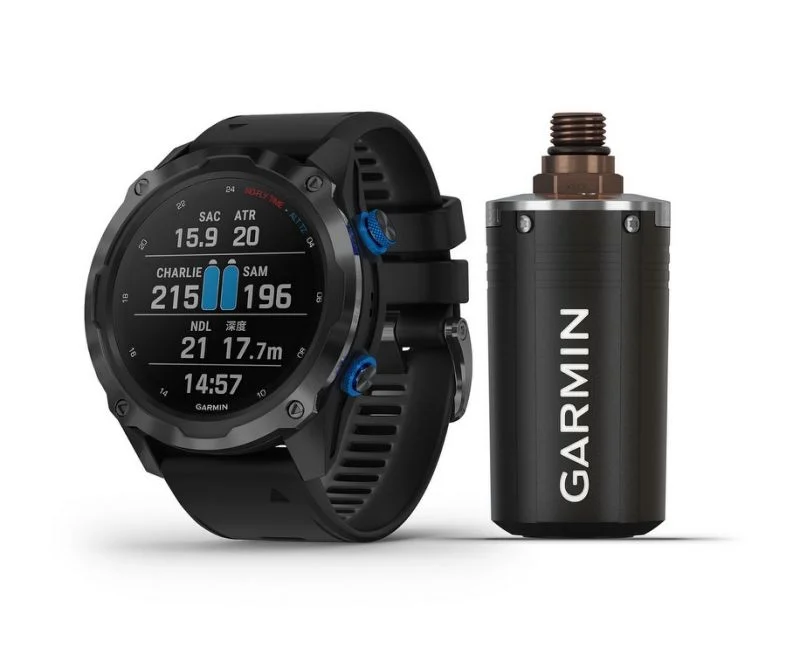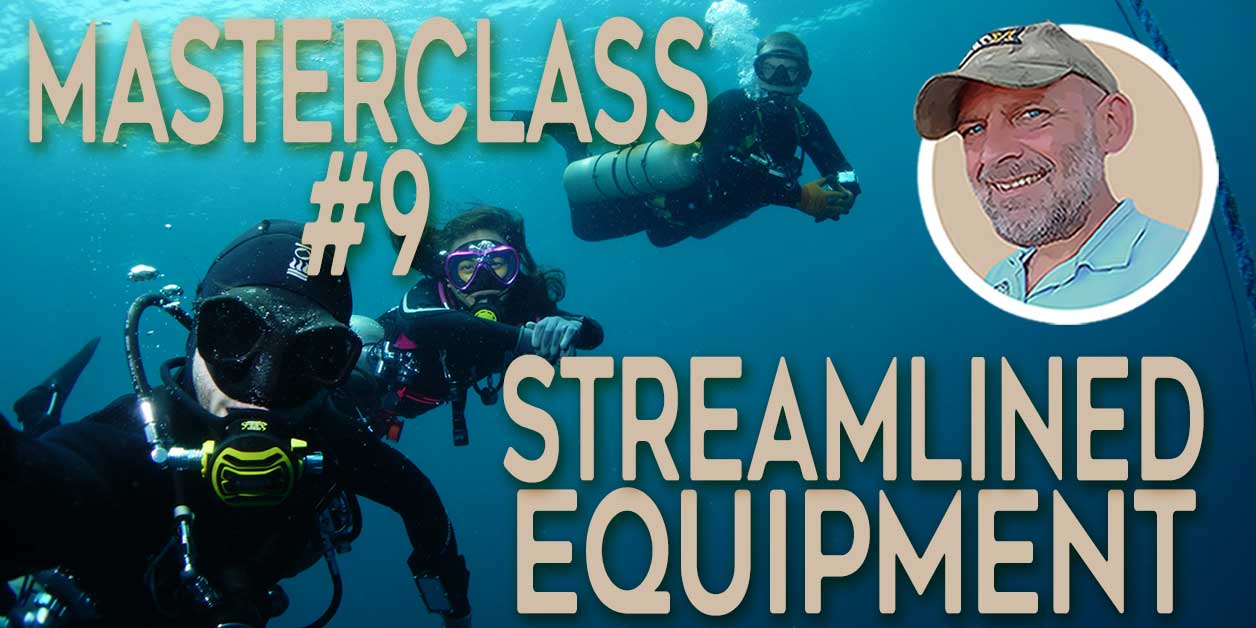AI Dive Computers – Using Air Integrated Transmitters for Diving
AI dive computers are a hot topic of debate amongst scuba divers. Some believe that air integrated computers are unnecessary, failure-prone and superfluously expensive. Others view the use of dive computers with gas transmitters as a safety benefit, a practical convenience and a tool that makes diving easier.
This article will explore those differing perspectives; evaluating the pros and cons of modern AI dive computer technology.
What is an AI dive computer?
Air integrated (AI) dive computers utilize a wireless transmitter on the scuba regulator to send gas supply information from the cylinder to the diver’s computer. The dive computer displays cylinder gas pressure on its screen.
An AI dive computer also performs calculations to determine the diver’s air consumption rate and predict how much dive time remains based on that speed of consumption. AI dive computers can also be set to alarm when the gas supply reaches the reserve level.

Why use an AI dive computer?
The most objective reason for choosing to use an air integration dive computer is if you are long-sighted and have difficulties reading an analogue SPG on your dives. Modern dive computers have brightly lit, often colourful, screens that are much easier to read.
The other possible reasons for using an AI dive computer are far more subjective and a matter of individual preference. Convenience, streamlined gear and improved gas management are typically strong factors in the decision-making process.
All of those factors can actually be attained through an improved skillset, more knowledge and greater attention to detail with one’s dive gear. However, in an era of bare minimum syllabus dive training, many divers simply don’t receive the tuition and professional role-modelling to have those proficiencies. AI dive computers cater for those deficits.
Convenience and ease
AI dive computers add convenience and ease when scuba diving. Firstly, all of your critical diving information, gas supply, no-stop time and depth, is readily available on your wrist. One glance at your dive computer tells you everything you need to know during a dive. There is no necessity to fumble around and locate your SPG routinely throughout the dive.
Modern dive computers create detailed dive logs and these can be transferred to and stored in dive log software on PCs and mobile devices. An AI dive computer automatically adds gas consumption data to that log; enabling the diver to understand how their breathing rate changed over a dive or improves over the long term.
Situational awareness
Having your gas supply information available at a glance on your wrist can improve your ability to constantly monitor the one resource that keeps you alive underwater. Less experienced divers frequently neglect to check their SPGs when distracted or task loaded on their dives.
Many AI dive computers also feature alarms. These typically warn the diver when they reach reserve gas pressure, although some dive computers also allow divers to set custom alarms for specific cylinder pressures.
Gas supply alarms can be especially beneficial for very inexperienced divers, or when diving at depths where nitrogen narcosis can subtly impede a diver’s ability to absorb, retain and process information.
Increased situational awareness of gas supply reduces the likelihood of the diver ever running low on gas; or, even worse, running out of gas entirely.
Situational awareness is a proficiency that is rarely focused upon during the average recreational diving course. It can be developed through deliberate practice, but more commonly divers are left to develop the competency as they slowly acquire diving experience.
Streamlining dive gear
Some divers buy an AI dive computer with the intention of making their dive gear more minimalist and streamlined. They can remove the analogue SPG and high-pressure hose from their regulator.
This factor is similar to the reason why some divers also opt for an AIR2-type inflator regulator. It reduces the number of hoses from their regulator and makes their gear configuration less cluttered.
Potentially, with an AI dive computer and an AAS-inflator, the diver would only need two hoses on their regulator, one for their own second stage and one neatly over their shoulder to their LPI.
Although AI dive computer transmitters still fail frequently enough that the majority of users eventually resort to replacing the SPG back onto their gear as a backup.
Gas management calculations
AI dive computers also do all of the work calculating gas consumption rates and predicting gas supply duration in real-time during dives.
Accurate gas management calculations are not taught in most recreational diving courses, so the functionality of AI dive computers can seem invaluable to the many divers that don’t experience exemplary dive training.
Divers who are taught how to simply calculate their gas consumption and plan dives with that information typically find AI dive computers less appealing.
Many scuba divers just love the latest technology
Some people love to upgrade their iPhones with every new release. There is an understandable appeal to owning and using the latest technology available. Scuba diving gear is no exception to that; some scuba divers will simply enjoy having the latest technology, features and gadgets.
Whilst this may be the most superficial reason for choosing an AI dive computer, it is entirely valid and relatable. There are many reasons why people love scuba diving and finding joy in dive gear is one of them.
What are the benefits of an AI dive computer?
The benefits of using an air integration diving computer with transmitters are:
- Gas supply awareness is improved
- Low gas alarm if you get distracted
- All critical dive information is on your wrist
- Easier to read than an SPG with weak eyesight
- Easier to read than an SPG in dark conditions
- The gas remaining dive time is calculated
- Gas consumption rates are calculated
- Gas details are logged and trackable over time
What are the drawbacks of an AI dive computer?
The drawbacks of using an air integration diving computer with transmitters are:
- Purchase cost is much more expensive
- Transmitter connections can fail when diving
- Many divers still use an analogue SPG as backup
- If the dive computer fails, you lose all critical information
- Impedes long-term development of intuitive gas management
What AI dive computers are available?
There is a growing demand for air integrated diving technology, so most major dive computer manufacturers now offer their premium products with an AI purchase option.
Typically the price for an AI version of a dive computer is 30-50% higher than the non-AI version, depending on whether the transmitter is included in the package or not.
My recommendation for AI dive computers
Unless you are long-sighted and have actual vision difficulties reading an SPG, the important question is why you would actually need air integration for your gas management.
Every function that an AI dive computer provides can alternatively be gained through improving one’s competency and knowledge as a scuba diver. It’s easy to learn gas management calculations and situational awareness develops quickly if you focus on maintaining it.
Ultimately, AI dive computer technology allows less experienced and under-trained divers to circumvent having to learn fundamental diving proficiencies. It provides diving capabilities without having to invest time and effort in learning new things. The investment made instead is financial.
Is that wrong? No. The purpose of technology is to reduce mental and physical demands upon people. It allows a fast track to enable capabilities that would otherwise not be immediately accessible.
That said, as a technical diving instructor, I would counsel prudence in the pursuit of instant gratification and quick fixes. Avoiding the effort of learning new competencies can be detrimental in the long term.
Mentally calculating your gas consumption after dives, applying attention to detail with your dive gear configuration and not abdicating mental responsibility for situational awareness onto digital aids reflects the pursuit of an enviable level of diving proficiency and an advanced diving mindset.
In essence, there is a decision between gaining a capability in the short term versus developing a competency in the long term.
This is particularly relevant to divers who aspire to more challenging levels of diving; especially deeper, technical, wreck penetration and cave diving. Advanced divers cannot just rely on technology, they have to be capable of surviving their dives if the technology fails.
Developing fail-safe competency
When a digital device fails, as they are occasionally prone to do, the advanced diver has to rely upon their knowledge and experience to safely return from the dive. That knowledge and experience won’t have developed if they have always used technology to do the job for them.
When I served in the military, I was taught to navigate using a map and compass. We practised that regularly, despite using GPS devices all the time. The reason why that was taught and practised was to enable us to continue functioning should the technology become unavailable.
The same mentality is prudent with respect to AI dive computers and gas management skills.
Advanced diving and intuitive competencies
Over years of diving experience, I routinely calculated my gas consumption after dives. I used that information to plan subsequent dives. It became a habitual task. As my experienced progressed it became ingrained at an intuitive unconscious level.
Without conscious calculation, I just know what my gas consumption is. I know how long it will last at a given depth, or how much I need to complete a long ascent with stops. When I check a student’s or buddy’s gas during a dive, I know automatically what their consumption rate is.
If I lose gas due to an unexpected leak I immediately understand how that will affect my dive plan. The thought to turn around a dive will automatically pop into my head at the right time; I’ll always get the dive team back to the boat without anyone needing to consume their reserve gas. I can brief how long and deep a dive will be, and what gas pressure the divers will surface with, and I am usually exactly correct.
That intuitive accuracy is invaluable. It is only developed by routine cognitive processing. When a mental task happens frequently enough, the brain will hard-wire it into the unconscious to free up conscious mental processing resources. Because it’s an unconscious process, it isn’t degraded by stress during emergencies. It isn’t impaired by conscious distractions or higher task loading.
With the benefit of hindsight, I am extremely glad I decided not to rely upon AI dive computers during my formative years of diving. I am a far more capable diver now because of that.
Considering your dive goals and aspirations
The majority of this article makes a strong case for the benefit of AI dive computers, whilst the long-term drawback to using air integrated technology is more nuanced and less perceptible.
If you have aspirations to becoming a highly competent diver or progressing to technical or cave diving, then I’d suggest taking the opportunity to enjoy some ‘analogue’ diving. It’ll sharpen the brain-powered gas management skills you’ll eventually rely upon heavily in the future.
Consider that time and effort as an investment into becoming a truly skilled, highly competent diver. Avoiding complex tasks cannot improve your ability to deal efficiently with complexity. Advanced diving is complex, and that is what presents the biggest challenge to students.
If you have no aspirations to ever progress to advanced diving levels, then buying an AI dive computer has immediate advantages in keeping you safer and making your dives less complex. The decision becomes primarily about whether you can personally justify the additional cost of an AI dive computer.
Do you use an AI dive computer? Share your experiences and opinions in the comments below!
About The Author

Andy Davis is a RAID, PADI TecRec, ANDI, BSAC, and SSI-qualified independent technical diving instructor who specializes in teaching sidemount, trimix, and advanced wreck diving courses.
Currently residing in Subic Bay, Philippines; he has amassed more than 10,000 open-circuit and CCR dives over three decades of challenging diving across the globe.
Andy has published numerous diving magazine articles and designed advanced certification courses for several dive training agencies, He regularly tests and reviews new dive gear for scuba equipment manufacturers. Andy is currently writing a series of advanced diving books and creating a range of tech diving clothing and accessories.
Prior to becoming a professional technical diving educator in 2006, Andy was a commissioned officer in the Royal Air Force and has served in Iraq, Afghanistan, Belize, and Cyprus.
In 2023, Andy was named in the “Who’s Who of Sidemount” list by GUE InDepth Magazine.
Purchase my exclusive diving ebooks!
Originally posted 2023-01-08 18:16:53.














